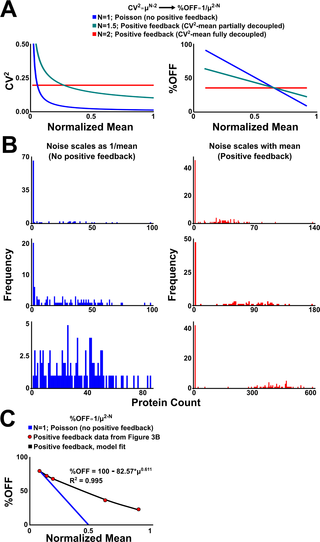PLOS Biology ( IF 7.8 ) Pub Date : 2017-10-18 , DOI: 10.1371/journal.pbio.2000841 Brandon S. Razooky , Youfang Cao , Maike M. K. Hansen , Alan S. Perelson , Michael L. Simpson , Leor S. Weinberger

|
Fundamental to biological decision-making is the ability to generate bimodal expression patterns where 2 alternate expression states simultaneously exist. Here, we use a combination of single-cell analysis and mathematical modeling to examine the sources of bimodality in the transcriptional program controlling HIV’s fate decision between active replication and viral latency. We find that the HIV transactivator of transcription (Tat) protein manipulates the intrinsic toggling of HIV’s promoter, the long terminal repeat (LTR), to generate bimodal ON-OFF expression and that transcriptional positive feedback from Tat shifts and expands the regime of LTR bimodality. This result holds for both minimal synthetic viral circuits and full-length virus. Strikingly, computational analysis indicates that the Tat circuit’s noncooperative “nonlatching” feedback architecture is optimized to slow the promoter’s toggling and generate bimodality by stochastic extinction of Tat. In contrast to the standard Poisson model, theory and experiment show that nonlatching positive feedback substantially dampens the inverse noise-mean relationship to maintain stochastic bimodality despite increasing mean expression levels. Given the rapid evolution of HIV, the presence of a circuit optimized to robustly generate bimodal expression appears consistent with the hypothesis that HIV’s decision between active replication and latency provides a viral fitness advantage. More broadly, the results suggest that positive-feedback circuits may have evolved not only for signal amplification but also for robustly generating bimodality by decoupling expression fluctuations (noise) from mean expression levels.
中文翻译:

非闩锁正反馈通过将表达噪声与均值解耦来实现鲁棒的双峰
生物学决策的基础是生成双峰表达模式的能力,其中同时存在2个替代表达状态。在这里,我们结合使用单细胞分析和数学模型来检查转录程序中控制艾滋病毒在主动复制和病毒潜伏期之间的命运决定的转录程序中的双峰源。我们发现,HIV转录反式激活蛋白(Tat)操纵着HIV的启动子,长末端重复序列(LTR)的固有转换,以生成双峰ON-OFF表达,并且Tat移位产生的转录阳性反馈和扩展了LTR双峰性的机制。该结果对于最小的合成病毒回路和全长病毒均成立。惊人地 计算分析表明,Tat电路的非合作“非锁存”反馈体系结构经过优化,可通过随机熄灭Tat来减慢启动子的切换并生成双峰。与标准Poisson模型相反,理论和实验表明,尽管平均表达水平不断提高,但非闩锁正反馈会大大抑制逆噪声-均值关系,以保持随机双峰性。鉴于HIV的迅速发展,优化存在以可靠生成双峰表达的电路的出现与以下假设相符:HIV在主动复制和潜伏期之间的决定提供了病毒适应性优势。更广泛地,











































 京公网安备 11010802027423号
京公网安备 11010802027423号